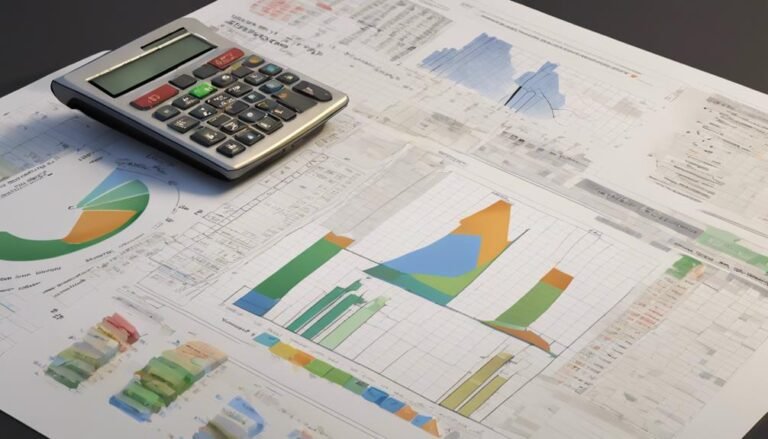Inventory Accounting: FIFO, LIFO, and Weighted Average Methods
When managing your inventory, you should know that FIFO method means oldest items sell first, good for accurate COGS. LIFO sells newest items first, affects profits and taxes. Weighted Average finds average cost per unit. Each method impacts financial statements and ratios differently. FIFO suits perishable goods, LIFO is good in inflation, and Weighted Average smooths price changes. Choosing the right method is key to sound financial decisions. Explore further for a deeper understanding of these inventory accounting methods.
Key Takeaways
- FIFO prioritizes earliest inventory for cost of goods sold.
- LIFO uses recent inventory first, impacting profits.
- Weighted average calculates cost using unit averages.
- Tax implications differ based on chosen method.
- Understanding impacts on financial statements is crucial.
FIFO Inventory Accounting Method
When utilizing the FIFO inventory accounting method, prioritize recording the earliest acquired inventory items first to calculate cost of goods sold accurately. This method assumes that the first items purchased are the first ones sold.
This approach is important for businesses looking to assess their inventory turnover analysis effectively. By assigning the cost of the oldest inventory to goods sold first, FIFO provides a more accurate reflection of current costs in the balance sheet.
Additionally, under FIFO, during inflationary periods, ending inventory is valued closer to current market prices, aligning with the cost flow assumptions. This helps in presenting a more realistic financial picture of the business.
FIFO is particularly beneficial for companies dealing with perishable goods or those prone to rapid price fluctuations. By adhering to FIFO, you establish a systematic and logical approach to managing your inventory and financial records efficiently.
LIFO Inventory Accounting Method
When utilizing the LIFO inventory accounting method, you record the most recent inventory purchases as the first ones sold, impacting your financial statements.
The Tax Implications of LIFO can influence your taxable income due to lower reported profits resulting from higher COGS.
Understanding these aspects of LIFO will help you make informed decisions regarding your inventory management and financial reporting practices.
Last In, First Out
Utilizing the Last In, First Out (LIFO) inventory accounting method involves allocating the most recently acquired inventory to the cost of goods sold first. This method assumes that the last items added to an inventory are the first to be sold. When it comes to inventory management, LIFO can be advantageous during times of rising prices. By assigning the most recent, and typically higher-priced, inventory to the cost of goods sold, the remaining inventory on the balance sheet is valued at older, lower costs. This can result in a lower taxable income due to the higher cost of goods sold.
When considering inventory turnover, LIFO may result in a lower turnover ratio compared to First In, First Out (FIFO) or weighted average methods. This is because the cost of goods sold is higher under LIFO, leading to a lower net income and potentially a higher carrying value of inventory. Understanding the impact of LIFO on inventory turnover is important for businesses aiming to optimize their inventory management strategies.
Tax Implications of LIFO
The tax implications of using the Last In, First Out (LIFO) inventory accounting method can have a substantial impact on a company's financial statements and taxable income. One significant advantage of LIFO is the potential tax savings it offers. By using LIFO, companies can match high-cost inventory with current revenues, resulting in lower reported profits and, consequently, reduced tax liabilities. However, it's crucial to recognize that while LIFO can provide tax benefits in the short term, it may lead to higher taxes in the future if inventory costs continue to rise.
Financial reporting implications arise due to the stark contrast between LIFO and other inventory accounting methods like FIFO or weighted average. LIFO typically results in lower ending inventory values, which can affect key financial ratios and metrics. Companies using LIFO should be mindful of these differences and make proper disclosure in their financial statements to provide transparency to investors and stakeholders. Despite its tax advantages, the choice to use LIFO should take into account both short-term benefits and long-term consequences on financial reporting.
Weighted Average Inventory Accounting Method
When using the Weighted Average Inventory Accounting Method, you'll calculate averages to determine the cost of goods sold and ending inventory.
This method helps maintain uniformity in cost allocation and simplifies inventory valuation.
Calculation of Averages
To determine the weighted average inventory using this method, multiply the cost of each unit by the number of units, then sum these values and divide by the total number of units. This calculation method involves incorporating both the cost and quantity of units to derive a thorough average cost per unit.
Moving average calculations involve recalculating the average cost after each purchase, ensuring a dynamic reflection of inventory value. Weighted average pricing accounts for fluctuations in unit costs by considering both recent and historical data.
By multiplying the cost of each unit by its quantity, you assign a weight to each unit's cost based on its volume in inventory. Summing these values provides a total weighted cost, which when divided by the total number of units, yields the weighted average cost per unit.
This meticulous approach offers a detailed perspective on inventory valuation, catering to the dynamic nature of costs within a business operation.
Cost Uniformity Maintenance
In weighted average inventory accounting, maintaining cost uniformity involves consistently recalculating the average cost per unit to reflect the dynamic changes in inventory value. This method guarantees a smooth cost flow and effective inventory control.
Here's how to maintain cost uniformity in weighted average inventory accounting:
- Recalculate Average Cost: Regularly update the average cost per unit by dividing the total cost of goods available for sale by the total number of units available for sale.
- Include New Purchases: When new inventory is acquired, incorporate the cost of these units into the average calculation to reflect the most recent costs.
- Factor in Sales: Adjust the average cost after each sale by removing the cost of the sold units from the calculation to account for the remaining inventory at the new average cost.
- Consistent Application: Make sure that the weighted average method is consistently applied to all inventory transactions to maintain accuracy in cost flow and inventory control.
Inventory Valuation Simplification
For guaranteeing inventory valuation using the weighted average accounting method, maintaining consistent cost calculations is essential to ensure accurate financial reporting and effective inventory management. This method simplifies complexity by streamlining calculations through a straightforward approach.
To begin, total the cost of goods available for sale during the accounting period, including opening inventory and purchases. Next, count the total number of units available for sale to calculate the weighted average cost per unit. Divide the total cost by the total number of units to determine the weighted average cost. This cost is then applied to both the ending inventory and the cost of goods sold.
By consistently using this method, you guarantee that your inventory valuation remains accurate and reflective of current market conditions. Additionally, it aids in making informed business decisions by providing a clear picture of your inventory's value.
Streamlining calculations through the weighted average method is a practical approach to maintaining precise inventory valuations.
Key Differences Between FIFO and LIFO
Diving into the comparison between FIFO and LIFO reveals distinct ways in which these inventory accounting methods differ. Here are the key differences:
- Inventory Flow: FIFO (First-In-First-Out) assumes that the first items added to inventory are the first ones sold. In contrast, LIFO (Last-In-First-Out) assumes that the most recently added items are the first to be sold. This impacts the flow of goods out of the inventory.
- Cost Layers: Under FIFO, the cost of goods sold is based on older, lower-cost items, leading to a lower cost of goods sold and higher net income during inflationary periods. On the other hand, LIFO matches current selling prices with the most recent, higher-cost items in inventory, resulting in a higher cost of goods sold and lower net income during inflation.
- Tax Implications: FIFO generally results in lower taxes during inflationary periods due to the higher reported income. In contrast, LIFO can provide tax advantages by matching current revenues with current costs.
- Balance Sheet Impact: FIFO tends to result in higher ending inventory values on the balance sheet during inflationary periods compared to LIFO, which may lead to better loan terms or investor perception.
Impact of Inventory Accounting Methods on Financial Statements
Analyzing various inventory accounting methods reveals substantial impacts on financial statements. The choice between FIFO, LIFO, or Weighted Average can have a significant effect on a company's reported earnings and financial ratios. Earnings manipulation is possible as each method allocates costs differently, impacting net income. For instance, FIFO usually results in higher reported earnings during inflationary periods, while LIFO tends to show lower profits. This manipulation can misrepresent a company's financial health.
Additionally, financial ratios like inventory turnover and gross profit margin can vary based on the chosen accounting method, influencing how investors perceive a business's performance.
Cash flow implications and tax reporting are also influenced by the inventory accounting method adopted. For example, LIFO often leads to lower taxable income due to higher cost of goods sold, impacting tax liabilities. Additionally, the method chosen affects cash flow from operations, financing, and investing activities, influencing a company's overall financial position. Understanding these impacts is essential for making informed decisions and accurately interpreting financial statements.
Advantages and Disadvantages of Weighted Average Method
Moving on from the impact of inventory accounting methods on financial statements, you can now explore the advantages and disadvantages of the Weighted Average Method.
Advantages:
- Simplicity: The Weighted Average Method is easy to calculate as it involves averaging the cost of goods available for sale.
- Smoothing Effects: It smoothens out price fluctuations by considering the average cost, which can be beneficial in volatile markets.
Disadvantages:
- Overgeneralization: It may not reflect the actual cost of the inventory on hand accurately, especially when prices vary greatly.
- Impact on Profit: During periods of price changes, the weighted average cost could distort profit margins compared to FIFO or LIFO methods.
Understanding these advantages and disadvantages can help you make an informed decision when choosing an inventory accounting method that best suits your business needs.
Implementing Inventory Accounting Methods in Practice
When implementing inventory accounting methods in practice, ensure that you meticulously align your chosen method with your business operations for best efficiency. It is essential to take into account factors such as the nature of your inventory, sales patterns, and industry standards. Two critical aspects to focus on during implementation are Inventory turnover analysis and Cost of goods sold calculation.
| Aspects | Importance | Considerations |
|---|---|---|
| Inventory turnover analysis | High | Track how quickly inventory is sold and replaced. This aids in optimizing stock levels. |
| Cost of goods sold calculation | High | Accurately computing this figure impacts profitability analysis and tax obligations. |
Conclusion
As you navigate the labyrinth of inventory accounting methods, remember that each path has its own twists and turns. Just like choosing the right path in a maze can lead to success or failure, selecting the most suitable inventory accounting method can greatly impact your financial statements.
By understanding the key differences between FIFO, LIFO, and weighted average methods, you can confidently steer your way towards financial clarity and success in your business endeavors. Choose wisely, and watch your profits bloom like a well-tended garden.








